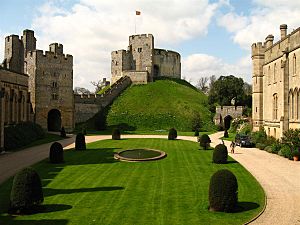Siege of Arundel facts for kids
Quick facts for kids Siege of Arundel (1643) |
|||||||
|---|---|---|---|---|---|---|---|
| Part of First English Civil War | |||||||
 Arundel Castle, 2006; the Norman keep (shown here) is the only survivor from 1643, the rest 19th century |
|||||||
|
|||||||
| Belligerents | |||||||
| Commanders and leaders | |||||||
| Joseph Bampfield Sir Edward Ford |
Sir William Waller John Birch (WIA) |
||||||
| Strength | |||||||
| 800 | 5,000 | ||||||
| Casualties and losses | |||||||
| Unknown | Unknown | ||||||
The Siege of Arundel was an important event during the First English Civil War. It happened from December 19, 1643, to January 6, 1644. During this time, a group of soldiers loyal to the King, called Royalists, were trapped inside Arundel Castle. They were surrounded by a much larger army of Parliamentarians, who supported the Parliament. This Parliamentarian army was led by Sir William Waller. In the end, the Royalist soldiers inside the castle had to give up, and the Parliamentarians won.
At the end of 1642, most of South-East England was controlled by Parliament. However, there were still some areas in Hampshire and Kent that supported the King. In October 1643, a Royalist leader named Sir Ralph Hopton moved his troops into Sussex. A small group of Royalist soldiers then took over Arundel Castle without a fight on December 2.
Hopton wanted to hold onto many towns, but this meant his soldiers were spread out. The Royalists did not have a fast-moving army to help places that were attacked. Arundel Castle was attacked by a large Parliamentarian force on December 19. Even though the castle was strong, bad weather and poor roads made it hard for help to arrive. The Royalists surrendered on January 6.
Contents
Why Did the Siege Happen?
When the First English Civil War started in August 1642, Parliament's forces took control of most of southern England. This included important ports like Southampton and Dover. They also controlled most of the Royal Navy, which was the King's fleet of ships. After the port of Portsmouth surrendered in September, Parliament controlled all major ports from Plymouth to Hull. This stopped the Royalists from bringing in weapons and soldiers from other countries in Europe.
This situation changed in July 1643. Sir Ralph Hopton, a Royalist commander, defeated Sir William Waller at the Battle of Roundway Down. This battle happened near Devizes.
Royalist Plans and Challenges
After this defeat, Parliamentarian groups in the west were left on their own. This allowed Prince Rupert, a Royalist leader, to capture Bristol on July 26. Bristol was the second-largest city in Britain. Taking it was a big win for the Royalists. It also allowed them to bring more troops from Ireland. With the South West of England now under Royalist control, they could threaten London. They hoped this would make people who wanted peace agree to talks.
At a meeting in Oxford, the Royalists made a plan. Prince Rupert would try to take Gloucester, which was Parliament's last big stronghold in the west. Then, he would march on London. Hopton was supposed to help by moving his army into Hampshire and Sussex. These areas had ironworks that made weapons for Parliament.
However, Hopton had problems. He didn't have enough money or supplies. Also, many of his foot soldiers were not well-trained. This delayed his plans until mid-October. By then, Prince Rupert had failed to take Gloucester. His march on London was stopped at the First Battle of Newbury on September 20. This battle did not have a clear winner. This was the best chance the Royalists had for a big victory. By the time Hopton was ready, their chances of winning the war were much lower.
Waller's Army and Royalist Positions
One of Hopton's officers, Sir William Ogle, was from Winchester. In late October, he found out that Parliament's soldiers had left Winchester. He quickly took over the town. This forced Hopton to move his army before he was fully ready. When Hopton reached Winchester in early November, his troops refused to obey orders. Some soldiers were executed before order was restored.
Meanwhile, Waller had gathered a new army at Farnham Castle. This army included local soldiers called Trained Bands from Kent, Sussex, and Hampshire. They were also joined by soldiers from London. During the war, both sides used these local militias. Their service was usually limited to 30 days and only in their home area. London's units were the largest and best equipped. They were often used to fill gaps in the army. Waller's army had several London regiments. After an attack on Basing House failed in November, these London soldiers wanted to go home.
Hopton marched towards Farnham, but he could not get Waller to fight a big battle. So, Hopton retreated. The Royalists set up their winter camps in different places in West Sussex and Hampshire. These included Alresford, Alton, and Petersfield. However, senior officers warned that these camps were too far apart to help each other quickly. On December 2, a small Parliamentarian group at Arundel Castle surrendered to Edward Ford. This happened after 36 men used a special explosive device called a petard to blow open the castle gate.
The Siege of Arundel Castle

The Earl of Essex, a Parliamentarian leader, told Waller to retake Alton and then Arundel. Waller convinced the London soldiers to help him capture Alton on December 13. But when he asked for their help with Arundel, they refused. They were sent home on December 15. The Royalist group in Arundel originally had 800 foot soldiers and four groups of horse soldiers. Hopton had taken the horse soldiers away before the siege began.
The governor of Arundel Castle was Colonel Joseph Bampfield. He was an experienced soldier. He built extra earth walls to defend the town from the north and south-west. He also brought in food and supplies from the nearby countryside. An attack by Royalists on Bramber, further east, was stopped. When Hopton heard that Alton was lost, he immediately ordered his men back to Arundel.
Fighting for the Castle
Even though Arundel was six miles from the sea, it was an important inland port. It was also the only Royalist position strong enough to resist a big attack. Waller arrived on December 19 with about 5,000 men. Most of these were local soldiers from the South-Eastern trained bands, and many were not very skilled. Waller immediately attacked the outer defenses on December 20. These defenses were captured after an initial setback. Lt-Colonel John Birch was shot in the stomach. People said he survived only because the cold weather stopped the bleeding.
The Royalist soldiers then went inside the castle. But they lost their supplies, which had been stored in the town. The Parliamentarian attackers also drained the lake, which was the castle's main water source. Oxford, a Royalist stronghold, sent Hopton an extra 1,000 horse soldiers. These were led by Lord Wilmot. But Hopton was very short of foot soldiers, having lost another 600 at Alton.
On December 27, Hopton advanced from Winchester with 2,000 horse soldiers and 1,500 foot soldiers. Waller left a small group of soldiers to continue the siege. He then went to stop Hopton at North Marden, which was 15 miles from Arundel. Hopton's forces were outnumbered, so he pulled back. This allowed Waller to bring up heavy cannons from Portsmouth. These cannons started firing on January 4. The Royalists inside the castle were weakened by a disease called typhus. They also ran out of supplies. So, they surrendered on January 6. About 100 of them joined the Parliamentarian army. The rest were sent to London as prisoners.
Colonel Sir William Springett was made the commander of the Parliamentarian soldiers in the castle. But he died of fever on February 3. Captain William Morley took his place. Bampfield later wrote about the siege. He said that sickness and injuries had reduced his soldiers to fewer than 200 healthy men. Waller agreed that Bampfield had defended the castle bravely. But Hopton blamed Bampfield for the defeat. Hopton's version of events appeared in a famous book called "History of the Rebellion." Bampfield was held prisoner for six months. Then, he was exchanged for two Parliamentarian officers held in Oxford.
What Happened Next?

After losing Arundel, King Charles I told Hopton to move his army into Wiltshire. This would keep him in contact with Bristol. However, Hopton convinced the King that he should stay in Hampshire. He argued that he needed to stop Waller's horse soldiers from attacking Royalist areas in the west. On January 12, 1644, Waller told the Earl of Essex that he was making Arundel stronger and bringing in more supplies. Then, heavy snow stopped military actions for several weeks.
By the end of February, Waller's army had grown to over 8,000 soldiers. He was ordered to get past Hopton and retake the west. One of Waller's commanders, Sir Richard Grenville, left Waller's side and joined Hopton in early March. He told Hopton about Waller's plans. But Waller still defeated Hopton at the Battle of Cheriton on March 29. Ogle kept Winchester until October 1645. However, this battle ended any major Royalist threat to the south-east of England.
Waller put a permanent group of soldiers in Arundel Castle. The castle was used to store military supplies and hold prisoners. In May 1645, Captain Morley was made governor. He stayed in this job until 1653. At that time, the castle's walls and defenses were destroyed, or 'slighted'. This was part of a bigger plan to make the New Model Army smaller. It meant fewer soldiers were needed to guard castles.
Lady Mary, the wife of Sir William Springett, wrote a detailed description of how the siege affected Arundel. She said the town was 'depopulated,' meaning many people had left. She also wrote that 'all the windows broke with the guns.' Soldiers even used the shops and lower rooms as stables for their horses. Her daughter, Guielma, was born a few days after her father's death. Guielma later married William Penn, who founded Pennsylvania. This story was used by the author Hester Burton in her 1969 novel Thomas.
Images for kids




